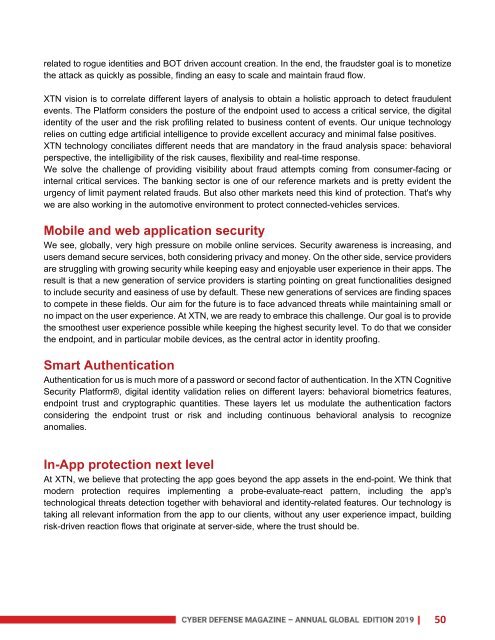Cyber Defense Magazine Global Edition for 2019
Cyber Defense Magazine's Annual Global Edition for 2019: Will Quantum resilient encryption change the future against breaches in our favor? Can deception technology stop the next wave of cybercriminals? This and much more inside this 78 page eMagazine exclusively distributed at www.ipexpoeurope.com each year along with our announcement of the Cyber Defense Global Awards winners for 2019; also found at www.cyberdefenseawards.com.
Cyber Defense Magazine's Annual Global Edition for 2019: Will Quantum resilient encryption change the future against breaches in our favor? Can deception technology stop the next wave of cybercriminals? This and much more inside this 78 page eMagazine exclusively distributed at www.ipexpoeurope.com each year along with our announcement of the Cyber Defense Global Awards winners for 2019; also found at www.cyberdefenseawards.com.
Create successful ePaper yourself
Turn your PDF publications into a flip-book with our unique Google optimized e-Paper software.
elated to rogue identities and BOT driven account creation. In the end, the fraudster goal is to monetize<br />
the attack as quickly as possible, finding an easy to scale and maintain fraud flow.<br />
XTN vision is to correlate different layers of analysis to obtain a holistic approach to detect fraudulent<br />
events. The Plat<strong>for</strong>m considers the posture of the endpoint used to access a critical service, the digital<br />
identity of the user and the risk profiling related to business content of events. Our unique technology<br />
relies on cutting edge artificial intelligence to provide excellent accuracy and minimal false positives.<br />
XTN technology conciliates different needs that are mandatory in the fraud analysis space: behavioral<br />
perspective, the intelligibility of the risk causes, flexibility and real-time response.<br />
We solve the challenge of providing visibility about fraud attempts coming from consumer-facing or<br />
internal critical services. The banking sector is one of our reference markets and is pretty evident the<br />
urgency of limit payment related frauds. But also other markets need this kind of protection. That's why<br />
we are also working in the automotive environment to protect connected-vehicles services.<br />
Mobile and web application security<br />
We see, globally, very high pressure on mobile online services. Security awareness is increasing, and<br />
users demand secure services, both considering privacy and money. On the other side, service providers<br />
are struggling with growing security while keeping easy and enjoyable user experience in their apps. The<br />
result is that a new generation of service providers is starting pointing on great functionalities designed<br />
to include security and easiness of use by default. These new generations of services are finding spaces<br />
to compete in these fields. Our aim <strong>for</strong> the future is to face advanced threats while maintaining small or<br />
no impact on the user experience. At XTN, we are ready to embrace this challenge. Our goal is to provide<br />
the smoothest user experience possible while keeping the highest security level. To do that we consider<br />
the endpoint, and in particular mobile devices, as the central actor in identity proofing.<br />
Smart Authentication<br />
Authentication <strong>for</strong> us is much more of a password or second factor of authentication. In the XTN Cognitive<br />
Security Plat<strong>for</strong>m®, digital identity validation relies on different layers: behavioral biometrics features,<br />
endpoint trust and cryptographic quantities. These layers let us modulate the authentication factors<br />
considering the endpoint trust or risk and including continuous behavioral analysis to recognize<br />
anomalies.<br />
In-App protection next level<br />
At XTN, we believe that protecting the app goes beyond the app assets in the end-point. We think that<br />
modern protection requires implementing a probe-evaluate-react pattern, including the app's<br />
technological threats detection together with behavioral and identity-related features. Our technology is<br />
taking all relevant in<strong>for</strong>mation from the app to our clients, without any user experience impact, building<br />
risk-driven reaction flows that originate at server-side, where the trust should be.<br />
50


















